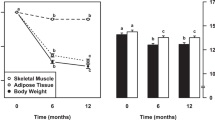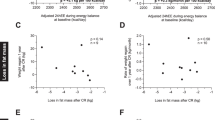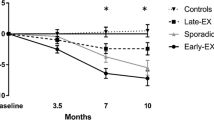Abstract
Background/Objectives:
Normal-weight women frequently restrict their caloric intake and exercise, but little is known about the effects on body weight, body composition and metabolic adaptations in this population.
Subjects/Methods:
We conducted a secondary analysis of data from a randomized controlled trial in sedentary normal-weight women. Women were assigned to a severe energy deficit (SEV: −1062±80 kcal per day; n=9), a moderate energy deficit (MOD: −633±71 kcal per day; n=7) or energy balance (BAL; n=9) while exercising five times per week for 3 months. Outcome variables included changes in body weight, body composition, resting metabolic rate (RMR) and metabolic hormones associated with energy conservation.
Results:
Weight loss occurred in SEV (−3.7±0.9 kg, P<0.001) and MOD (−2.7±0.8 kg; P=0.003), but weight loss was significantly less than predicted (SEV: −11.1±1.0 kg; MOD: −6.5±1.1 kg; both P<0.001 vs actual). Fat mass declined in SEV (P<0.001) and MOD (P=0.006), whereas fat-free mass remained unchanged in all groups (P>0.33). RMR decreased by −6±2% in MOD (P=0.020). In SEV, RMR did not change on a group level (P=0.66), but participants whose RMR declined lost more weight (P=0.020) and had a higher baseline RMR (P=0.026) than those whose RMR did not decrease. Characteristic changes in leptin (P=0.003), tri-iodothyronine (P=0.013), insulin-like growth factor-1 (P=0.016) and ghrelin (P=0.049) occurred only in SEV. The energy deficit and adaptive changes in RMR explained 54% of the observed weight loss.
Conclusions:
In normal-weight women, caloric restriction and exercise resulted in less-than-predicted weight loss. In contrast to previous literature, weight loss consisted almost exclusively of fat mass, whereas fat-free mass was preserved.
This is a preview of subscription content, access via your institution
Access options
Subscribe to this journal
Receive 12 print issues and online access
$259.00 per year
only $21.58 per issue
Buy this article
- Purchase on Springer Link
- Instant access to full article PDF
Prices may be subject to local taxes which are calculated during checkout



Similar content being viewed by others
References
Hill JO . Understanding and addressing the epidemic of obesity: an energy balance perspective. Endocr Rev 2006; 27: 750–761.
Donnelly JE, Blair SN, Jakicic JM, Manore MM, Rankin JW, Smith BK . American College of Sports Medicine Position Stand. Appropriate physical activity intervention strategies for weight loss and prevention of weight regain for adults. Med Sci Sports Exerc 2009; 41: 459–471.
Seagle HM, Strain GW, Makris A, Reeves RS . Position of the American Dietetic Association: weight management. J Am Diet Assoc 2009; 109: 330–346.
Fayet F, Petocz P, Samman S . Prevalence and correlates of dieting in college women: a cross sectional study. Int J Womens Health 2012; 4: 405–411.
Kruger J, Galuska DA, Serdula MK, Jones DA . Attempting to lose weight: specific practices among U.S. adults. Am J Prev Med 2004; 26: 402–406.
Bosy-Westphal A, Muller MJ . Measuring the impact of weight cycling on body composition: a methodological challenge. Curr Opin Clin Nutr Metab Care 2014; 17: 396–400.
Dulloo AG, Jacquet J, Montani JP, Schutz Y . How dieting makes the lean fatter: from a perspective of body composition autoregulation through adipostats and proteinstats awaiting discovery. Obes Rev 2015; 16 (Suppl 1), 25–35.
Wishnofsky M . Caloric equivalents of gained or lost weight. Am J Clin Nutr 1958; 6: 542–546.
Hall KD, Sacks G, Chandramohan D, Chow CC, Wang YC, Gortmaker SL et al. Quantification of the effect of energy imbalance on bodyweight. Lancet 2011; 378: 826–837.
Weinheimer EM, Sands LP, Campbell WW . A systematic review of the separate and combined effects of energy restriction and exercise on fat-free mass in middle-aged and older adults: implications for sarcopenic obesity. Nutr Rev 2010; 68: 375–388.
Forbes GB . Lean body mass-body fat interrelationships in humans. Nutr Rev 1987; 45: 225–231.
Thomas DM, Bouchard C, Church T, Slentz C, Kraus WE, Redman LM et al. Why do individuals not lose more weight from an exercise intervention at a defined dose? An energy balance analysis. Obes Rev 2012; 13: 835–847.
Hall KD . What is the required energy deficit per unit weight loss? Int J Obes 2008; 32: 573–576.
Martin CK, Heilbronn LK, de Jonge L, DeLany JP, Volaufova J, Anton SD et al. Effect of calorie restriction on resting metabolic rate and spontaneous physical activity. Obesity 2007; 15: 2964–2973.
Redman LM, Heilbronn LK, Martin CK, de Jonge L, Williamson DA, DeLany JP et al. Metabolic and behavioral compensations in response to caloric restriction: implications for the maintenance of weight loss. PLoS One 2009; 4: e4377.
Blüher S, Mantzoros CS . Leptin in humans: lessons from translational research. Am J Clin Nutr 2009; 89: 991S–997S.
Loucks AB . Energy balance and body composition in sports and exercise. J Sports Sci 2004; 22: 1–14.
Cummings DE . Ghrelin and the short- and long-term regulation of appetite and body weight. Physiol Behav 2006; 89: 71–84.
Loucks AB, Kiens B, Wright HH . Energy availability in athletes. J Sports Sci 2011; 29 (Suppl 1), S7–15.
Williams NI, Leidy HJ, Hill BR, Lieberman JL, Legro RS, Souza MJ . Magnitude of daily energy deficit predicts frequency but not severity of menstrual disturbances associated with exercise and caloric restriction. Am J Physiol Endocrinol Metab 2015; 308: E29–E39.
Crujeiras AB, Goyenechea E, Abete I, Lage M, Carreira MC, Martinez JA et al. Weight regain after a diet-induced loss is predicted by higher baseline leptin and lower ghrelin plasma levels. J Clin Endocrinol Metab 2010; 95: 5037–5044.
Haas V, Onur S, Paul T, Nutzinger DO, Bosy-Westphal A, Hauer M et al. Leptin and body weight regulation in patients with anorexia nervosa before and during weight recovery. Am J Clin Nutr 2005; 81: 889–896.
Burger KS, Berner LA . A functional neuroimaging review of obesity, appetitive hormones and ingestive behavior. Physiol Behav 2014; 136: 121–127.
Reinehr T . Obesity and thyroid function. Mol Cell Endocrinol 2010; 316: 165–171.
Onur S, Haas V, Bosy-Westphal A, Hauer M, Paul T, Nutzinger D et al. L-tri-iodothyronine is a major determinant of resting energy expenditure in underweight patients with anorexia nervosa and during weight gain. Eur J Endocrinol 2005; 152: 179–184.
Ihle R, Loucks AB . Dose-response relationships between energy availability and bone turnover in young exercising women. J Bone Miner Res 2004; 19: 1231–1240.
Williams NI, Reed JL, Leidy HJ, Legro RS, Souza MJ . Estrogen and progesterone exposure is reduced in response to energy deficiency in women aged 25-40 years. Hum Reprod 2010; 25: 2328–2339.
Leidy HJ, Gardner JK, Frye BR, Snook ML, Schuchert MK, Richard EL et al. Circulating ghrelin is sensitive to changes in body weight during a diet and exercise program in normal-weight young women. J Clin Endocrinol Metab 2004; 89: 2659–2664.
Gardner JK, McConnell H, Frye BR, Dougherty KA, Parrott TS, Richard EL et al. Validation of an improved method to estimate energy requirements in college-aged women: the PERK method. Med Sci Sports Exerc 2004; 36: 79.
Spurr GB, Dufour DL, Reina JC, Haught TA . Daily energy expenditure of women by factorial and heart rate methods. Med Sci Sports Exerc 1997; 29: 1255–1262.
Brozek J, Grande F, Anderson JT, Keys A . Densitometric analysis of body composition: revision of some quantitative assumptions. Ann N Y Acad Sci 1963; 110: 113–140.
Weir JB . New methods for calculating metabolic rate with special reference to protein metabolism. J Physiol 1949; 109: 1–9.
Cunningham JJ . Body composition as a determinant of energy expenditure: a synthetic review and a proposed general prediction equation. Am J Clin Nutr 1991; 54: 963–969.
Levine JA . Measurement of energy expenditure. Public Health Nutr 2005; 8: 1123–1132.
Crouter SE, Albright C, Bassett DR Jr . Accuracy of polar S410 heart rate monitor to estimate energy cost of exercise. Med Sci Sports Exerc 2004; 36: 1433–1439.
Maddison R, Jiang Y, Hoorn SV, Mhurchu CN, Lawes CM, Rodgers A et al. Estimating energy expenditure with the RT3 triaxial accelerometer. Res Q Exerc Sport 2009; 80: 249–256.
Rowlands AV, Thomas PW, Eston RG, Topping R . Validation of the RT3 triaxial accelerometer for the assessment of physical activity. Med Sci Sports Exerc 2004; 36: 518–524.
National Institute of Diabetes and Digestive and Kidney Diseases. Body weight planner. United States Department of Health and Human Services..
Byrne NM, Wood RE, Schutz Y, Hills AP . Does metabolic compensation explain the majority of less-than-expected weight loss in obese adults during a short-term severe diet and exercise intervention? Int J Obes 2012; 36: 1472–1478.
Del Corral P, Chandler-Laney PC, Casazza K, Gower BA, Hunter GR . Effect of dietary adherence with or without exercise on weight loss: a mechanistic approach to a global problem. J Clin Endocrinol Metab 2009; 94: 1602–1607.
Moreira EA, Most M, Howard J, Ravussin E . Dietary adherence to long-term controlled feeding in a calorie-restriction study in overweight men and women. Nutr Clin Pract 2011; 26: 309–315.
Goele K, Bosy-Westphal A, Rumcker B, Lagerpusch M, Muller MJ . Influence of changes in body composition and adaptive thermogenesis on the difference between measured and predicted weight loss in obese women. Obes Facts 2009; 2: 105–109.
Kosmiski L, Schmiege SJ, Mascolo M, Gaudiani J, Mehler PS . Chronic starvation secondary to anorexia nervosa is associated with an adaptive suppression of resting energy expenditure. J Clin Endocrinol Metab 2014; 99: 908–914.
Muller MJ, Bosy-Westphal A . Adaptive thermogenesis with weight loss in humans. Obesity 2013; 21: 218–228.
Muller MJ, Enderle J, Pourhassan M, Braun W, Eggeling B, Lagerpusch M et al. Metabolic adaptation to caloric restriction and subsequent refeeding: the Minnesota Starvation Experiment revisited. Am J Clin Nutr 2015; 102: 807–819.
Wade GN, Schneider JE, Li HY . Control of fertility by metabolic cues. Am J Physiol 1996; 270 (1 Pt 1), E1–19.
Vyver E, Steinegger C, Katzman DK . Eating disorders and menstrual dysfunction in adolescents. Ann N Y Acad Sci 2008; 1135: 253–264.
Gibbs JC, Williams NI, De Souza MJ . Prevalence of individual and combined components of the female athlete triad. Med Sci Sports Exerc 2013; 45: 985–996.
Acknowledgements
This study was supported by the National Institutes of Health Grants RO1-HD-39245-01 (NIW) and M01-RR-10732, and the Department of Kinesiology, Women’s Health and Exercise Laboratory, Penn State University. KK was supported through a Research Fellowship awarded by the German Academic Exchange Service (DAAD).
Author information
Authors and Affiliations
Corresponding author
Ethics declarations
Competing interests
The authors declare no conflict of interest.
Rights and permissions
About this article
Cite this article
Koehler, K., De Souza, M. & Williams, N. Less-than-expected weight loss in normal-weight women undergoing caloric restriction and exercise is accompanied by preservation of fat-free mass and metabolic adaptations. Eur J Clin Nutr 71, 365–371 (2017). https://doi.org/10.1038/ejcn.2016.203
Received:
Revised:
Accepted:
Published:
Issue Date:
DOI: https://doi.org/10.1038/ejcn.2016.203
This article is cited by
-
The Influence of Energy Balance and Availability on Resting Metabolic Rate: Implications for Assessment and Future Research Directions
Sports Medicine (2023)
-
The Skeletal Muscle Response to Energy Deficiency: A Life History Perspective
Adaptive Human Behavior and Physiology (2022)
-
Association of energy availability with resting metabolic rates in competitive female teenage runners: a cross-sectional study
Journal of the International Society of Sports Nutrition (2021)
-
Overtraining Syndrome (OTS) and Relative Energy Deficiency in Sport (RED-S): Shared Pathways, Symptoms and Complexities
Sports Medicine (2021)
-
Endpoint of Bariatric Surgery is Not Only Preservation of Free Fat Mass but Restoration of Normal Body Composition
Obesity Surgery (2017)



